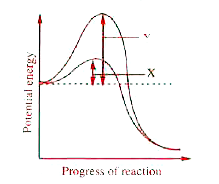According to the Lock and Key model, the mechanism of an enzyme catalysed reaction (where E= enzyme , S = substrate , ES = enzyme -substrate activated complex and P = product) is -Solution in Bengali
The correct Answer is:C
Step by step video, text & image solution for According to the Lock and Key model, the mechanism of an enzyme catalysed reaction (where E= enzyme , S = substrate , ES = enzyme -substrate activated complex and P = product) is - by Chemistry experts to help you in doubts & scoring excellent marks in Class 12 exams.
Updated on:21/07/2023Topper's Solved these Questions
- SURFACE CHEMISTRYBOOK - CHHAYA PUBLICATIONCHAPTER - SURFACE CHEMISTRYEXERCISE - Exercise
48 Videos
- SURFACE CHEMISTRYBOOK - CHHAYA PUBLICATIONCHAPTER - SURFACE CHEMISTRYEXERCISE - Practice set 5
13 Videos
- SURFACE CHEMISTRYBOOK - CHHAYA PUBLICATIONCHAPTER - SURFACE CHEMISTRYEXERCISE - Solved NECRT Exempler Problems
77 Videos
- SOME p-BLOCK ELEMENTSBOOK - CHHAYA PUBLICATIONCHAPTER - SOME p-BLOCK ELEMENTSEXERCISE - PRACTIVE SET 11
15 Videos
Similar Questions
Under similar experimental conditions, which out of CO2 and N2 gets adsorbed on finely divided charcoal to a greater extent?
View SolutionThe process by which alum purifies turbid water is
View SolutionWhich of the following process does not occur at the interface of phases-
View SolutionHow will you separate CO and CO2 from a mixture?
View SolutionAssertion : Each enzyme has a substrate binding site in its molecule which forms highly reactive enzyme-substrate complex.
Reason : The enzyme-substrate complex is long-lived and dissociates into its product and unchanged enzyme.
A: Assertion is correct and reason is the correct explanation of assertion.
B: Assertion is correct but reason is not the correct explanation of it.
C: Assertion is true and reason is false
D: Both assertion and reason are false.
View SolutionAssertion : Enzyme substrate complex remains throughout the reaction.
Reason : The greater the affinity of the enzyme for a substrate, the higher is the catalytic activity.
View SolutionFormation of enzyme substrate complex (ES) is the first step in catalysed reactions. Describe the other steps till the function of product.
View SolutionSTATEMENT-1 : According to the lock - and - key model. When the key (substrate) fits the lock (active site) the chemical change bedins. STATEMENT-2 : Modern X-ray crystallographic and spectroscopic methods show that in many cases, the enzyme changes shape when the substrate lands at the active site. STATEMENT- 3 : Enzyme catalysed reactions processed through a fast, reversible formation of an enzyme substrate complex, followed by a slow conversion to product and free enzyme.
View SolutionWhat happens to the substrate in an enzyme catalysed reaction?
View SolutionSubstrate and product are stable in any enzyme - catalysed reaction. The transitional states between the stable substrate and the product in the reaction are
View Solutionলক এন্ড কী মতবাদ অনুসারে এনজাইম অনুঘটন বিক্রিয়ার ক্রিয়াকৌশল (যেখানে E=এনজাইম , S=সাবস্ত্রেট, ES=এনজাইম -সাবস্ত্রেট, সক্রিয় জটিল যৌগ এবং P=বিক্রিয়াজাত পদার্থ) হল-
View SolutionFormation of Enzyme substrate complex (ES) is the first step in the catalysed reactions. Describe the other steps till the formation of product.
View SolutionIn a reaction, 120 substrate molecules are converted to products in 5 minutes . TON of enzyme is 12. What is the number of enzymes catalysing the reaction ?
View SolutionWhat is denoted by X and Y in the given graph?

XY1) Activation energy without enzymeActivation energy with enzyme2) Activation energy with enzyme Activation energy without enzyme3) Substrate concentration with enzymeSubstrate concentration without enzyme4) Substrate concentration without enzymeSubstrate concentration with enzyme
View SolutionArrange the steps of catalytic action of an enzyme in order and choose the right option:-
(A) The enzyme releases the products of the reaction and the free enzyme is ready to bind to another molecule of the substrate
(B) The active site of the enzyme, now in close proximity of the substrate breaks the chemical bonds of the substrate and the new enzyme-product complex is formed
(C) The binding of the substrate induces the enzyme to alter its shape, fitting more tightly around the substrate
(D) The substrate binds to the active site of the enzyme, fitting into the active site
View Solution
